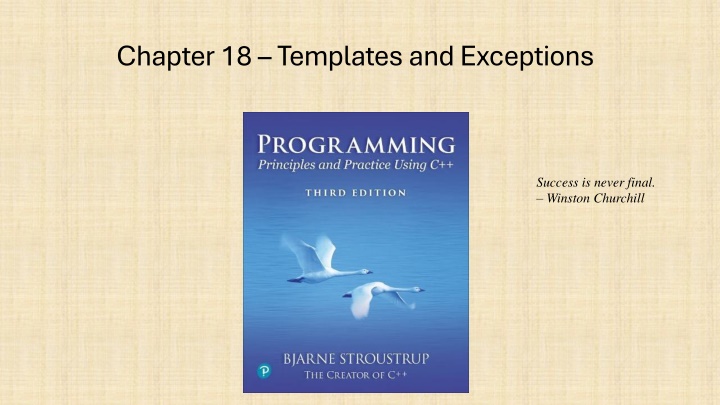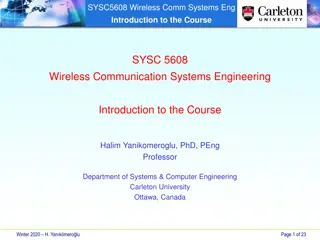Wireless and Mobile Networks Design
Explore the design and laboratory aspects of wireless and mobile networks, integrating visual art, computer science, and music characteristics. Learn about frequency and amplitude detection, color and brightness modulation, and challenges faced in signal processing and network environments.
Download Presentation

Please find below an Image/Link to download the presentation.
The content on the website is provided AS IS for your information and personal use only. It may not be sold, licensed, or shared on other websites without obtaining consent from the author.If you encounter any issues during the download, it is possible that the publisher has removed the file from their server.
You are allowed to download the files provided on this website for personal or commercial use, subject to the condition that they are used lawfully. All files are the property of their respective owners.
The content on the website is provided AS IS for your information and personal use only. It may not be sold, licensed, or shared on other websites without obtaining consent from the author.
E N D
Presentation Transcript
Chapter 18 Templates and Exceptions Success is never final. Winston Churchill
Overview Templates Generalizing Vector Allocators Range checking and exceptions Resources and exceptions RAII for Vector Resource-management pointers Return by moving, unique_ptr, and shared_ptr Stroustrup/Programming/2024/Chapter18 3
We now have a decent Vector of doubles But we don t just want a Vector of doubles We want vectors with element types we specify Vector<double> Vector<int> Vector<Month> Vector<Record*> Vector<Vector<Record>> Vector<char> We must make the element type a parameter to Vector both built-in types and user-defined types as element types This is not some magic reserved for the compiler we can define our own parameterized types, called templates // vector of pointers // vector of vector of Records Stroustrup/Programming/2024/Chapter18 4
Templates The basis for generic programming in C++ Sometimes called parametric polymorphism Parameterization of types (and functions) by types (and integers) Unsurpassed flexibility and performance Used where performance is essential (e.g., hard real time and numerics) Used where flexibility is essential (e.g., the C++ standard library) Template definitions template<class T, int N> class Buffer { /* */ }; template<class T, int N> void fill(Buffer<T,N>& b) { /* */ } Template specializations (instantiations) // for a class template, you specify the template arguments: Buffer<char,1024> buf; // for buf, T is char and N is 1024 // for a function template, the compiler deduces the template arguments: fill(buf); // for fill(), T is char and N is 1024; that s what buf has Stroustrup/Programming/2024/Chapter18 5
Parameterize with element type // an almost real vector of Ts: template<class T> class Vector { // }; Vector<double> vd; Vector<int> vi; Vector<Vector<int>> vvi; Vector<char> vc; Vector<double*> vpd; Vector<Vector<double>*> vvpd; // T is double // T is int // T is Vector<int> in which T is int // T is char // T is double* // T is Vector<double>* in which T is double Stroustrup/Programming/2024/Chapter18 6
Basically, Vector<double> is // an almost real Vector of doubles: class Vector { int sz; double* elem; int space; public: Vector() : sz(0), elem(0), space(0) { } explicit Vector(int s) :sz(s), elem(new double[s]), space(s) { } Vector(const Vector&); Vector& operator=(const Vector&); ~vector() { delete[ ] elem; } // double& operator[ ] (int n) { return elem[n]; } int size() const { return sz; } // }; // the size // a pointer to the elements // size+free_space // defaultconstructor // constructor //copy constructor //copy assignment //destructor // access: return reference // the current size Stroustrup/Programming/2024/Chapter18 7
Basically, Vector<char> is // an almost real Vector of chars: class Vector { int sz; char* elem; int space; public: Vector() : sz{0}, elem{0}, space{0} { } explicit Vector(int s) :sz{s}, elem{new char[s]}, space{s} { } Vector(const Vector&); Vector& operator=(const Vector&); ~Vector() { delete[ ] elem; } // char& operator[ ] (int n) { return elem[n]; } int size() const { return sz; } // }; // the size // a pointer to the elements // size+free_space // defaultconstructor // constructor //copy constructor //copy assignment //destructor // access: return reference // the current size Stroustrup/Programming/2024/Chapter18 8
Basically, vector<T> is // an almost real Vector of Ts: template<class T> class Vector { int sz; T* elem; int space; public: Vector() : sz{0}, elem{0}, space{0}; explicit Vector(int s) :sz{s}, elem{new T[s]}, space{s} { } Vector(const Vector&); Vector& operator=(const Vector&); ~vector() { delete[ ] elem; } // T& operator[ ] (int n) { return elem[n]; } int size() const { return sz; } // }; // read for all types T (just like in math) // the size // a pointer to the elements // size+free_space // default constructor //constructor //copy constructor //copy assignment //destructor // access: return reference // the current size Stroustrup/Programming/2024/Chapter18 9
Template instantiation Consider template<typename T> class Vector {/* */ }; void fct(Vector<string>& v) { int n = v.size(); v.push_back("Ada"); // ... } Given that, the compiler generates definitions Vector<string>::size() { /* */ } Vector<string>::push_back(const string&) { /* */ } That s commonly called Template instantiation Note: the compiler can use information from different places to generate great code Template definition Template arguments Calling context Stroustrup/Programming/2024/Chapter18 10
What is Generic Programming? Suggestions The most general, most efficient, most flexible representation of concepts Alex Stepanov Using templates Writing code that works for a set of arguments that meets some requirements Parametric polymorphism Compile-time resolution of overloaded calls As opposed to the run-time resolution of virtual function calls in object-oriented programming Represent separate concepts separately in code and combine concepts freely wherever meaningful Focus on the design and use of generic functions: algorithm-oriented programming To simplify Generic programming : supported by templates, relying on compile-time resolution Object-oriented programming : supported by class hierarchies with virtual functions, allowing run-time resolution Stroustrup/Programming/2024/Chapter18 11
Concepts specifying template requirements Least specific, worst error messages: template<typename T> class Vector { /* ... */ }; // for all types T Specify requirements on T by a predicate: template<typename T> requires Element<T>() class Vector { /* ... */ }; // for all types T // such that Element<T>() is true Convenient shorthand: template<Element T> class Vector { /* ... */ }; // for all types T, such that T is an Element Stroustrup/Programming/2024/Chapter18 12
We have always had concepts A concept is a predicate stating what template requires of its template arguments Every successful generic library has some form of concepts In the designer s head In the documentation In comments Examples C/C++ built-in type concepts: arithmetic and floating Mathematical concepts like monad, group, ring, and field Graph concepts like edges and vertices, graph, DAG, ... STL concepts like iterators, sequences, and containers C++ offers direct language support A concept is a compile-time predicate Using concepts is easier than not using them Stroustrup - Generic Programming - Madrid 2024 13
Some useful concepts range<C>(): C can hold Elements and be accessed as a sequence random_access_iterator<Ran>(): Ran can be used to read and write a sequence repeatedly and supports subscripting using [ ] random_access_range<Ran>(): Ran is a range with random_access_iterators equality_comparable<T>(): We can compare two Ts for equality using == to get a Boolean result integral<T>(): A T is an integral type (like int) floating_point<T>(): A T is a floating-point type (like double) copyable<T>(): A T can be copied invocable<F,T...>(): We can call F with a set of arguments of the n specified types T1, T2, ... semiregular<T>(): A T can be copied, moved, and swapped (that is, a pretty normal type ) regular<T>(): T is semiregular and equality_comparable Stroustrup/Programming/2024/Chapter18 14
Generalizing Vector yet again Soon it will behave much like std::vector Containers needs to be able to control where their elements are stored Vector<string, my_string_allocator > v; Elements may be of types with non-trivial constructors and destructors Vector<Vector<string>> v; We need to be able to change the number of elements of a Vector v.push_back(x); v.resize(1 000 000); Stroustrup/Programming/2024/Chapter18 15
Allocators controlling memory management We don t always want to get our memory from new Many, important applications rely on their containers using specialized me memory pools template<typename T> class allocator { public: // ... T* allocate(int n); void deallocate(T* p, int n); }; // allocate space for n objects of type T // deallocate n objects of type T starting at p <Element T, typename A = allocator<T>> class Vector { A alloc; // ... }; // use alloc to handle memory for elements Stroustrup/Programming/2024/Chapter18 16
Element construction and destruction Every element must be constructed before use Like every object Every element of a type with a destructor must be destroyed after its last use Like every object of a type with a destructor The space for elements are acquired from the Vector s allocator And must be given back to that allocator when the Vector is done with it Stroustrup/Programming/2024/Chapter18 17
reserve() The key operation for relocating elements into a new and larger space template<Element T, Allocator A> void Vector<T,A>::reserve(int newalloc) { if (newalloc<=space) return; T* p = alloc.allocate(newalloc); uninitialized_move(elem,&elem[sz],p); destroy(elem,space); alloc.deallocate(elem,capacity()); elem = p; space = newalloc; } // never decrease allocation // allocate new space // move elements into uninitialized space // destroy old elements // deallocate old space Stroustrup/Programming/2024/Chapter18 18
push_back() Given reserve(), push_back() is very simple template<Element T, Allocator A> void Vector<T,A>::push_back(const T& val) { reserve((space==0) ? 8 : 2*space); construct_at(&elem[sz],val); ++sz; } // get more space // construct val at end (using a standard-library function) // increase the size Stroustrup/Programming/2024/Chapter18 19
resize() Again, all the hard work is done in reserve() template<Element T, Allocator A> void Vector<T,A>::resize(int newsize, T val = T()) { reserve(newsize); if (sz<newsize) uninitialized_fill(&elem[sz],&elem[newsize],val); if (newsize<sz) destroy(&elem[newsize],&elem[sz]); sz = newsize; } // initialize added elements to val // destroy surplus original elements Stroustrup/Programming/2024/Chapter18 20
Range checking // an almost real Vector of Ts: template<class T> class Vector { T* elem; // T& operator[ ](int n) { return elem[n]; } // }; // access not range checked Vector<int> v(10); for (int i; cin>>i; ) v[i] = 7; // horror! Maul arbitrary memory location We need to do something about that! Stroustrup/Programming/2024/Chapter18 21
Range checking void fill_vec(vector<int>& v, int n) { for (int i=0; i<n; ++i) v.push_back(factorial(i)); } // initialize v with factorials int main() { vector<int> v; try { } catch (out_of_range) { cout << "out of range error"; return 1; } } fill_vec(v,10); for (int i=0; i<=v.size(); ++i) cout << "v[" << i << "]==" << v[i] << '\n'; // we ll get here (why?) Stroustrup/Programming/2024/Chapter18 22
Vector range checking first attempt template<Element T, Allocator A = allocator<T>> class Vector { // ... T& at(int n) { if (0<n || size()<=n) throw out_of_tange{}; return elem[n]; } // checked access }; T& operator[](int n) { return elem[n]; } // ... // unchecked access Vector v(100); V[100] = 7; V.at(100) = 7; // error not caught // error caught Stroustrup/Programming/2024/Chapter18 23
Vector range checking first attempt Rather messy, error-prone The standard-library vector guarantees checking only for at() Use a standard-library implementation that check s [ ] ; every major implementation has one Use PPP s vector; it checks Why doesn t the standard guarantee checking? Checking cost in speed and code size Not much; don t worry about that cost No student project needs to worry Few real-world projects need to worry Some projects need optimal performance Think huge (e.g., server farm) and tiny (e.g., smart watch) The standard must serve everybody You can build checked on top of optimal You can t build optimal on top of checked Some projects are not allowed to use exceptions Old projects with pre-exception parts High reliability, hard-real-time code (think airplanes) That design was approved in the 1990s The world was different than Stroustrup/Programming/2024/Chapter18 24
PPP::Checked_vector This is what PPP gives you (called vector in user code) namespace PPP { template<Element T> struct Checked_vector : public std::vector<T> { using size_type = typename std::vector<T>::size_type; using value_type = T; using vector<T>::vector; // constrain element types // use vector<T>'s constructors } // namespace PPP }; // Checked_vector // checked span and string T& operator[](size_type i) { return std::vector<T>::at(i); } // // here, we check Stroustrup/Programming/2024/Chapter18 25
Resources and exceptions A resource is something that we must acquire and later release If resources aren t released the system will eventually grind to a halt If resources are held for too long the system slows down Examples of resources Memory Locks File handles Thread handles Sockets Windows Shaders in graphics systems We are not good at returning/releasing resources Release must be made implicit Stroustrup/Programming/2024/Chapter18 26
No concern about resources Asking for trouble void suspicious(int s, int x) { int* p = new int[s]; // ... if (x==0) if (0<x) // ... delete[] p; } // acquire memory return; // we may return p[x] = v.at(x); // subscripting may throw // release memory Imagine if this was in a large function with complex control structures First: avoid large functions with complex control structures Stroustrup/Programming/2024/Chapter18 27
Ad hoc resource management Na ve ad hoc patch void suspicious(int s, int x) { int* p = new int[s]; vector<int> v; // ... try { } catch (...) { } // ... delete[] p; } // messy code // acquire memory if (x) // ... p[x] = v.at(x); // subscripting may throw // catch every exception // release memory // re-throw the exception so that a called can handle the error delete[] p; throw; // release memory Stroustrup/Programming/2024/Chapter18 28
Ad hoc resource management doesnt scale How many try-catch clauses do you need to get this right? void suspicious(int s) { int* p = new T[s]; // ... int* q = new T[s]; // ... delete[] p; // ... delete[] q; } Stroustrup/Programming/2024/Chapter18 29
Resource management Simple, general solution RAII: Resource Acquisition is initialization Also known as scoped resource management void f(vector<int>& v, int s) { vector<int> p(s); vector<int> q(s); // . . . } // vector s destructor releases memory upon scope exit Stroustrup/Programming/2024/Chapter18 30
RAII (Resource Acquisition Is Initialization) for Vector Vector acquires memory for elements in its constructor Manage it (changing size, controlling access, etc.) Gives back (releases) the memory in the destructor This is a special case of the general resource management strategy called RAII Also called scoped resource management Use it wherever you can It is simpler and cheaper than anything else It interacts beautifully with error handling using exceptions Examples of resources: Memory, file handles, sockets, I/O connections (iostreams handle those using RAII), locks, widgets, threads. Stroustrup/Programming/2024/Chapter18 31
Nave constructor Leaks memory and other resources but does not create bad vectors template<class T, class A> vector<T,A>::vector(size_type n, const T& val, const A& a) :alloc{a}, sz{n}, space{n} { v = alloc.allocate(n); for (T* p = v; p!=v+sz; ++p) a.construct_at(p,val); } // copy allocator, set size, no added spare space // get memory for elements // copy val into elements What happens if the allocation fails? What happens if an element constructor fails? Stroustrup - error handling - Columbia'23 32
std::unititialized_fill() offers the strong guarantee: either the initialization succeeds or no change template<class For, class T> void uninitialized_fill(For beg, For end, const T& val) { For p; try { // construct elements: for (p=beg; p!=end; ++p) a.construct_at(&*p,val); } catch ( ) { // undo construction: for (For q = beg; q!=p; ++q) a.destroy_at(&*q) throw; } } // astandard-library algorithm // construct val in *p // destroy // rethrow Stroustrup - error handling - Columbia'23 33
Nave constructor (2) Better, but it still leaks memory template<class T, class A> vector<T,A>::vector(size_type n, const T& val, const A& a) :alloc{a}, sz{n}, space{n} { v = a.allocate(n); uninitialized_fill(v,v+sz,val); } // copy allocator, set size, no added spare space // get memory for elements // copy val into elements Stroustrup - error handling - Columbia'23 34
RAII for Vector Represent ideas at types So, we define a type to represent the memory used by a Vector It deal only with memory, not with typed objects template<typename T, typename A = allocator<T>> struct Vector_rep { A alloc; int sz; T* elem; int space; // allocator // number of elements // start of allocation // amount of allocated space }; Vector_rep(const A& a, int n) : alloc{ a }, sz{ n }, elem{ alloc.allocate(n) }, space{ n } { } ~Vector_rep() { alloc.deallocate(elem, space); } Stroustrup/Programming/2024/Chapter18 35
RAII for Vector Now Vector deals only with turning memory into objects (and back again) And controlling access to those objects template<typename T, typename A = allocator<T>> class Vector { Vector_rep<T,A> r; public: Vector() : r{A{},0} { } } explicit Vector(int s, const T val = T{}) :r{A{},s} { uninitialized_fill(elem,elem+sz,val); } // ... // elements are initialized Stroustrup/Programming/2024/Chapter18 36
reserve() template<Element T, Allocator A> void Vector<T,A>::reserve(int newalloc) { if (newalloc<=r.space) return; // never decrease allocation T* p = alloc.allocate(newalloc); uninitialized_move(elem,&elem[sz],p); // allocate new space // move elements into uninitialized space destroy(elem,space); alloc.deallocate(elem,capacity()); // destroy old elements // deallocate old space } elem = p; space = newalloc; Stroustrup/Programming/2024/Chapter18 37
resize() template<Element T, Allocator A> void Vector<T,A>::resize(int newsize, T val = T{}) { reserve(newsize); if (sz<newsize) uninitialized_fill(&elem[sz],&elem[newsize],val); if (newsize<sz) destroy(&elem[newsize],&elem[sz]); sz = newsize; } // initialize added elements to val // destroy surplus original elements Stroustrup/Programming/2024/Chapter18 38
Resource management But what about functions creating objects? Traditional, error-prone solution: return a pointer vector<int>* make_vec() // make a filled vector { vector<int>* p = new vector<int>; // we allocate on free store // . . . fill the vector with data; this may throw an exception . . . return p; } auto q = make_vec(); // now users must remember to delete q // they will occasionally forget: leak! Stroustrup/Programming/2024/Chapter18 39
Return by moving Thanks to move semantics and copy elision returning a container is cheap Just return by value vector<int> make_vec() // make a filled vector { vector<int> res; // . . . fill the vector with data; this may throw an exception . . . return res; // moves the vector; doesn t copy elements } // local variable with elements on free store auto v = make_vec(); // No manual resource management Stroustrup/Programming/2024/Chapter18 40
unique_ptr But what about functions that create polymorphic objects? use std::unique_ptr; it s a pointer but it handles deletion unique_ptr<Shape> read_shape(istream& is) { // ... read a variety of shapes ... switch (p) { case read_a_circle: case read_a_triangle: return make_unique<Triangle>(p1,p2,p3); // } } return make_unique<Circle>(center,radius); auto q = read_shape(ifile); // users don t have to delete; no delete in user code // a unique_ptr owns its object and deletes it automatically Stroustrup/Programming/2024/Chapter18 41
shared_ptr But what if we need to share the polymorphic object? use std::shared_ptr; there can be many shared_ptrs to an object; the last shared_ptr destroys destroys the object shared_ptr<Shape> read_shape(istream& is) { // ... read a variety of shapes ... switch (p) { case read_a_circle: case read_a_triangle: return make_shared<Triangle>(p1,p2,p3); // } } return make_shared<Circle>(center,radius); auto q = read_shape(ifile); other_fct(q); // users don t have to delete; no delete in user code Stroustrup/Programming/2024/Chapter18 42
Next lecture An introduction to the STL, the containers and algorithms part of the C++ standard library. Here we ll meet sequences, iterators, and containers. Further lectures will introduce more containers (such as list and map) and algorithms on containers and other sequences. Stroustrup/Programming/2024/Chapter18 43























